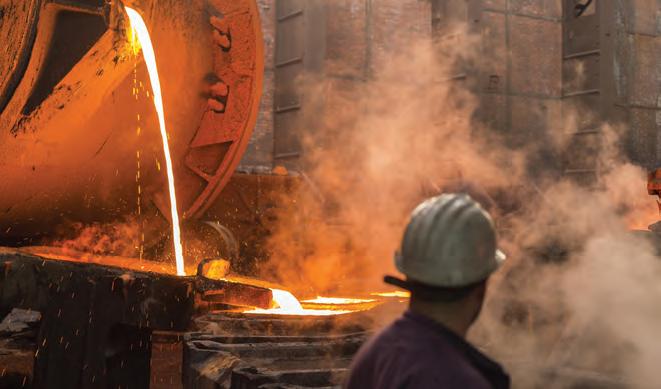
4 minute read
Shifting decarbonisation expectations
Coal is at risk of shifting mineral demand.
Ebbs and flows of mining commodities

The increasing demand for decarbonisation at mining operations has pushed companies to introduce emission-reduction goals.
Management consulting firm McKinsey & Company reveals the targets range from 0 to 30 per cent by 2030, well below the Paris Agreement goals.
Reaching the 1.5–2 degrees Celsius global warming limit will require significant global action, one that could result in a shifting demand for minerals, according to McKinsey.
All sectors will need to halve their carbon dioxide emissions from 2010 levels by 2050.
To limit warming to 1.5 degrees Celsius, a reduction of more than 85 per cent will be required.
McKinsey predicts in a report, Climate risk and decarbonisation: What every mining CEO needs to know, that coal will be “the most obvious victim” of shifts in mineral demand.
“Decarbonisation of the power sector would mean taking net greenhouse gas (GHG) emissions to zero, implying an almost complete reduction in the combustion of coal,” the report states.
Every year the mining industry produces between 1.9 and 5.1 gigatonnes of carbon dioxide equivalent of GHG emissions, according to McKinsey.
The majority of emissions, between 1.5 to 4.6 gigatonnes, come from fugitive coal-bed methane that is discharged during coal mining, mainly at underground operations, the report continues.
“Decarbonising the mining industry would require a serious effort by the coal industry, particularly in tackling fugitive methane,” it states.
Though methane capturing NOT ALL COMMODITIES STAND TO LOSE TO THE THREATS OF CLIMATE CHANGE. MCKINSEY & COMPANY REVEALS MINING ASSETS THAT ARE MOST AT RISK AND WAYS TO DECARBONISE OPERATIONS. Copper demand is expected to rise amid electrification.
technology exists today, McKinsey notes the investment isn’t economical in many cases.
“Mines theoretically can fully decarbonise (excluding fugitive methane) through operational efficiency, electrification, and renewable energy use,” the report states.
“Capital investments are required to achieve most of the decarbonisation potential, but certain measures, such as the adoption of renewables, electrification and operational efficiency, are economical today for many mines.”
This involves the switch from diesel trucks and gas-consuming appliances to electrified machinery.
Fortescue Metals Group made a notable move into renewable energy at its Pilbara iron ore mines in Western Australia last year with plans to introduce solar power at operations.
Australia’s largest mining company, BHP, has also signed contracts for renewable energy at the Escondida and Spence copper mines in Chile.
In February, Rio Tinto announced a project that will see its most technologically forward Pilbara iron ore project, Koodaideri, powered with a 34-megawatt solar plant.
“The construction of our first solar plant in the Pilbara is a significant milestone for the business and an important step in reducing our carbon footprint in the region,” Rio Tinto iron ore chief executive Chris Salisbury says.
The opportunity is in front of the mining industry as it continues to provide the raw materials required for decarbonisation solutions, the report adds.
Decarbonisation technologies span from wind turbines to solar photovoltaics, from electric vehicles to energy storage and from metal recycling to hydrogen fuel cells.
McKinsey outlines that this will inevitably alter demand patterns for upstream commodities. The switch to electric vehicles is a strategy for decarbonisation.

Niche materials such as cobalt, nickel, platinum, palladium and rare earths could be winners in this demand shift, along with the electrification of vehicles.
“Many of the world’s biggest mining companies will need to rebalance nondiverse mineral portfolios,” McKinsey states.
“Copper-heavy portfolios may benefit from demand growth related to widespread electrification, for example.
“And iron ore and aluminium-heavy portfolios may see an upside from decarbonisation technologies, but they are also more likely to be hit by rising recycling rates.”
The impact would be increasing mining costs that drive commodity prices higher.
McKinsey recommends that mining executives conduct an end-to-end diagnostic of climate change’s effect on their business to identify assets that need protecting from climate change, and which stand to gain or lose from decarbonisation.
“Mining is no stranger to harsh climates … We find that today, 30 to 50 per cent of production of (copper, gold, iron ore and zinc) is concentrated in areas where water stress is already high,” the report notes.
“In 2017, these sites accounted for roughly $150 billion in total annual revenues and were clustered into seven water-stress hot spots for mining: Central Asia, the Chilean coast, eastern Australia, the Middle East, southern Africa, Western Australia and a large zone in western North America.”
To improve resiliency, Anglo American improved evaporation monitoring at the Drayton mine dam in Australia, for example.
More capital-intensive approaches, though expensive, may also be necessary for the long term, according to McKinsey.
At the other end of the spectrum, northern Australia is considered to be a “wet spot”.
This region is likely to experience a 50 to 60 per cent increase in extreme precipitation this century.
Iron ore and zinc are the most exposed to extremely high flood occurrences, requiring companies to adopt flood-proof mine designs, adapt roads and use conveying methods that don’t rely on trucking.
“(Actions on climate change in the mining industry) are too modest to reach the 1.5 degrees Celsius to two degrees Celsius scenario and may not be keeping up with society’s expectations,” McKinsey states.
“Mining companies concerned about their long-term reputation, ‘licence to operate,’ or contribution to decarbonisation efforts may start to consider more aggressive decarbonisation and resilience plans.”










